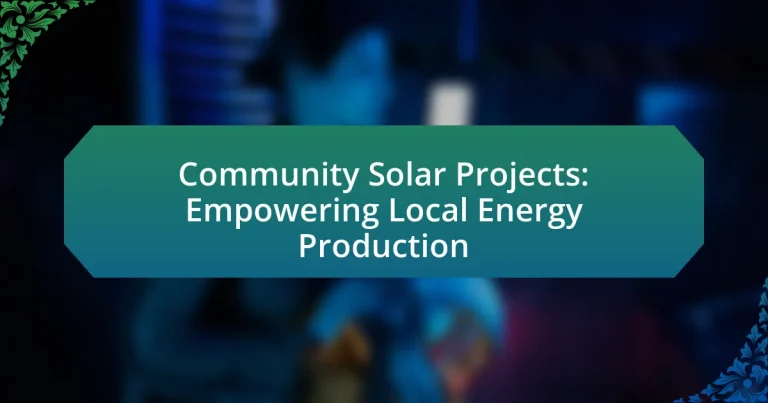Community solar projects are collaborative initiatives that enable multiple participants, including individuals, businesses, and organizations, to invest in or benefit from shared solar energy systems without the need for personal solar panel installations. These projects operate by generating electricity from solar arrays located off-site, which is then fed into the local grid, allowing participants to receive credits on their utility bills. Key components include community participation, a subscription model, and off-take agreements, all of which promote wider access to renewable energy and contribute to local economies through job creation and reduced energy costs. The article explores the operational mechanisms, benefits, challenges, and best practices associated with community solar projects, highlighting their role in enhancing sustainability and energy equity within communities.

What are Community Solar Projects?
Community solar projects are initiatives that allow multiple participants to invest in or benefit from a shared solar energy system. These projects enable individuals, businesses, and organizations to access solar power without needing to install solar panels on their own properties. According to the National Renewable Energy Laboratory, community solar can increase access to renewable energy for those who may not have suitable rooftops or the financial means to invest in solar technology directly.
How do Community Solar Projects operate?
Community solar projects operate by allowing multiple participants to invest in or subscribe to a shared solar energy system, typically located off-site. These projects generate electricity that is fed into the local grid, and participants receive credits on their utility bills based on their share of the energy produced. This model enables individuals, businesses, and organizations to benefit from solar energy without needing to install panels on their own properties, thus promoting wider access to renewable energy. According to the National Renewable Energy Laboratory, community solar can increase solar adoption by providing options for those who cannot install solar panels due to financial, structural, or other constraints.
What are the key components of a Community Solar Project?
The key components of a Community Solar Project include a solar array, community participation, a subscription model, and an off-take agreement. The solar array serves as the physical installation where solar energy is generated, typically located in a shared space accessible to multiple participants. Community participation involves local residents or businesses who subscribe to the project, allowing them to benefit from the energy produced without needing to install solar panels on their own properties. The subscription model outlines how participants pay for their share of the energy generated, often through monthly fees or upfront payments. An off-take agreement is a contract that specifies how the energy produced will be distributed and compensated, ensuring that participants receive credits or payments for their share of the solar energy. These components work together to create a sustainable and inclusive energy solution for communities.
How is energy generated and distributed in Community Solar Projects?
Energy in Community Solar Projects is generated through solar panels installed in a shared location, typically on rooftops or open land, which capture sunlight and convert it into electricity. This electricity is then fed into the local grid or distributed directly to participating community members, allowing them to benefit from renewable energy without needing to install their own solar systems. According to the National Renewable Energy Laboratory, community solar projects can increase access to solar energy for those who may not have suitable roofs or the financial means to invest in individual solar installations, thus promoting local energy production and sustainability.
What are the benefits of Community Solar Projects?
Community Solar Projects provide multiple benefits, including increased access to renewable energy, cost savings, and enhanced community engagement. These projects allow individuals and businesses to participate in solar energy production without needing to install solar panels on their properties. According to the National Renewable Energy Laboratory, community solar can reduce energy costs by up to 10% for participants, making renewable energy more affordable. Additionally, these projects foster local job creation and economic development, as they often involve local contractors and suppliers. By promoting shared ownership and investment in renewable energy, Community Solar Projects strengthen community ties and encourage collective action towards sustainability.
How do Community Solar Projects contribute to local economies?
Community solar projects contribute to local economies by creating jobs, increasing local tax revenues, and providing affordable energy options. These projects typically require a workforce for installation and maintenance, generating employment opportunities in construction, engineering, and operations. For instance, a report from the National Renewable Energy Laboratory indicates that community solar projects can create approximately 1.5 jobs per installed kilowatt. Additionally, local governments benefit from increased tax revenues generated by these installations, which can be reinvested into community services. Furthermore, community solar initiatives often offer lower energy costs for participants, enhancing economic stability for households and businesses.
What environmental advantages do Community Solar Projects provide?
Community Solar Projects provide significant environmental advantages by promoting the use of renewable energy sources, specifically solar power, which reduces greenhouse gas emissions. By harnessing solar energy, these projects decrease reliance on fossil fuels, leading to lower carbon footprints. According to the U.S. Department of Energy, solar energy can reduce carbon dioxide emissions by approximately 0.85 pounds per kilowatt-hour generated, contributing to cleaner air and mitigating climate change. Additionally, Community Solar Projects often utilize previously developed land, minimizing habitat disruption and preserving natural ecosystems. This approach supports biodiversity while facilitating local energy production, making it a sustainable choice for communities.

Who can participate in Community Solar Projects?
Individuals, businesses, and organizations can participate in Community Solar Projects. These projects are designed to allow participants to invest in or subscribe to a portion of a larger solar energy installation, typically located off-site. According to the National Renewable Energy Laboratory, community solar programs are accessible to renters, homeowners, and businesses that may not have suitable rooftops for solar panels, thus broadening access to renewable energy.
What types of participants are involved in Community Solar Projects?
Community Solar Projects involve several types of participants, including project developers, local governments, utility companies, investors, and community members. Project developers are responsible for designing and implementing the solar installations, while local governments may provide permits and support for the projects. Utility companies often facilitate the integration of solar energy into the grid and may offer incentives for participation. Investors provide the necessary funding for the projects, and community members, who can be residential or commercial customers, subscribe to the solar energy produced, benefiting from reduced energy costs. This collaborative approach enhances local energy production and promotes renewable energy adoption.
How can individuals benefit from participating in Community Solar Projects?
Individuals can benefit from participating in Community Solar Projects by gaining access to renewable energy, reducing their electricity bills, and contributing to local sustainability efforts. Community Solar Projects allow individuals, especially those who cannot install solar panels on their properties, to invest in shared solar energy systems. This participation often results in lower energy costs, as participants receive credits on their utility bills based on the energy produced by the solar project. Additionally, these projects promote environmental benefits by increasing the use of clean energy sources, which can lead to a reduction in greenhouse gas emissions. According to the National Renewable Energy Laboratory, community solar can provide energy savings of 10-20% for participants, making it a financially attractive option.
What role do local governments play in Community Solar Projects?
Local governments play a crucial role in Community Solar Projects by facilitating regulatory approvals, providing incentives, and engaging with the community. They often streamline the permitting process, which can expedite project development and reduce costs. Additionally, local governments may offer financial incentives, such as tax credits or grants, to encourage investment in solar energy. For example, a study by the National Renewable Energy Laboratory found that local policies significantly impact the deployment of solar projects, highlighting the importance of local government support in achieving renewable energy goals.
What are the eligibility requirements for Community Solar Projects?
Community Solar Projects typically require participants to be residents or businesses within the utility service area where the project is located. Additionally, eligibility often includes having a utility account with the local energy provider and meeting any specific program guidelines set by the state or utility company. For instance, some programs may prioritize low-income households or offer incentives for energy efficiency measures. These requirements ensure that the benefits of community solar are accessible to those who contribute to and support local energy production.
How do income levels affect participation in Community Solar Projects?
Income levels significantly affect participation in Community Solar Projects, as lower-income households often face barriers such as upfront costs and lack of access to financing options. Research indicates that individuals with higher income levels are more likely to invest in solar projects due to their ability to afford initial investments and benefit from tax incentives. For instance, a study by the National Renewable Energy Laboratory found that households earning above the median income are more likely to enroll in community solar programs, highlighting the correlation between income and participation rates. Additionally, lower-income communities may lack awareness or resources to engage in these projects, further limiting their participation.
What geographic considerations are important for Community Solar Projects?
Geographic considerations for Community Solar Projects include solar irradiance, land availability, proximity to infrastructure, and local regulations. Solar irradiance affects energy production potential, with regions receiving higher sunlight being more favorable for solar installations. Land availability is crucial, as projects require sufficient space for solar panels, ideally on previously disturbed or underutilized land to minimize environmental impact. Proximity to existing electrical infrastructure, such as substations and transmission lines, facilitates easier integration into the grid, reducing costs and enhancing efficiency. Local regulations, including zoning laws and permitting processes, can significantly influence project feasibility and timelines, making it essential to understand these factors in the planning stages.

What challenges do Community Solar Projects face?
Community Solar Projects face several challenges, including regulatory hurdles, financing difficulties, and community engagement issues. Regulatory hurdles often arise from varying state policies and interconnection standards, which can complicate project development and increase costs. Financing difficulties stem from the need for substantial upfront capital, which can deter investors and limit project scalability. Additionally, community engagement issues can occur when potential participants lack awareness or understanding of the benefits of solar energy, leading to lower participation rates. These challenges can hinder the successful implementation and growth of Community Solar Projects, impacting their ability to empower local energy production effectively.
What regulatory hurdles impact Community Solar Projects?
Community Solar Projects face several regulatory hurdles, including interconnection standards, net metering policies, and state-specific legislation. Interconnection standards can delay project implementation due to complex requirements for connecting to the grid, which vary by utility and state. Net metering policies, which determine how solar energy credits are allocated, can significantly impact the financial viability of these projects; inconsistent policies across states create uncertainty for developers. Additionally, state-specific legislation may impose restrictions or additional requirements that complicate project approval processes, leading to increased costs and extended timelines. For instance, a report by the National Renewable Energy Laboratory highlights that regulatory barriers can increase project costs by up to 30%, underscoring the significant impact of these hurdles on the development of Community Solar Projects.
How do state policies influence the development of Community Solar Projects?
State policies significantly influence the development of Community Solar Projects by establishing regulatory frameworks, financial incentives, and interconnection standards. For instance, states with supportive policies, such as renewable portfolio standards and tax credits, encourage investment in community solar by reducing costs and providing clear guidelines for project implementation. According to the National Renewable Energy Laboratory, states like California and Massachusetts have successfully increased community solar capacity through such policies, demonstrating that favorable regulations can lead to higher adoption rates and project viability.
What are the common financial challenges for Community Solar Projects?
Common financial challenges for Community Solar Projects include high upfront capital costs, securing financing, and navigating regulatory complexities. High upfront capital costs can deter potential investors, as initial investments for solar infrastructure can range from hundreds of thousands to millions of dollars. Securing financing is often complicated by the need for long-term power purchase agreements, which can be difficult to negotiate. Additionally, regulatory complexities, such as varying state policies and incentives, can create uncertainty in financial projections and impact project viability. These challenges can hinder the growth and sustainability of community solar initiatives.
How can these challenges be overcome?
Community solar projects can overcome challenges through strategic partnerships, effective policy advocacy, and community engagement. Forming alliances with local governments, non-profits, and energy providers can enhance resource sharing and funding opportunities, as evidenced by successful initiatives in states like California, where collaborative efforts have led to increased project viability. Additionally, advocating for supportive policies, such as streamlined permitting processes and financial incentives, can reduce barriers to entry, as demonstrated by the Solar Energy Industries Association’s reports showing growth in states with favorable regulations. Engaging the community through education and outreach fosters local support and participation, which is crucial for project success, as seen in the success of community solar programs in Massachusetts, where public awareness campaigns significantly boosted enrollment rates.
What strategies can be implemented to enhance funding for Community Solar Projects?
To enhance funding for Community Solar Projects, implementing a combination of public-private partnerships, innovative financing models, and community engagement strategies is essential. Public-private partnerships can leverage government incentives and private investment to reduce financial barriers. Innovative financing models, such as green bonds or crowdfunding, can attract diverse funding sources and democratize investment opportunities. Community engagement strategies, including educational outreach and local stakeholder involvement, can increase public support and participation, thereby enhancing funding potential. For instance, a study by the National Renewable Energy Laboratory found that community-supported solar projects can increase local investment by up to 50% when residents are actively involved in the planning and funding processes.
How can community engagement improve the success of Community Solar Projects?
Community engagement can significantly improve the success of Community Solar Projects by fostering local support and participation. When community members are actively involved in the planning and decision-making processes, they are more likely to invest in and advocate for the project. Research indicates that projects with strong community involvement see higher participation rates, as evidenced by a study from the National Renewable Energy Laboratory, which found that community-driven solar initiatives can increase project acceptance and reduce barriers to implementation. Engaged communities also contribute valuable insights into local needs and preferences, ensuring that the solar solutions provided are tailored to maximize benefits for residents.
What are best practices for implementing Community Solar Projects?
Best practices for implementing Community Solar Projects include engaging stakeholders early, ensuring equitable access, and conducting thorough site assessments. Engaging stakeholders, such as local communities, government entities, and potential investors, fosters collaboration and addresses concerns, leading to smoother project execution. Ensuring equitable access allows diverse community members to participate, which can be achieved through tiered pricing models or subscription options. Conducting thorough site assessments is crucial for identifying optimal locations that maximize solar energy production while minimizing environmental impact. According to the National Renewable Energy Laboratory, projects that incorporate these practices tend to achieve higher participation rates and greater overall success.
How can communities effectively plan and launch a Community Solar Project?
Communities can effectively plan and launch a Community Solar Project by first conducting a feasibility study to assess local energy needs, available land, and potential solar resources. This initial step ensures that the project aligns with community goals and identifies suitable sites for solar installations.
Next, communities should engage stakeholders, including local government, residents, and potential investors, to gather support and secure funding. For instance, successful projects often utilize a combination of grants, loans, and community fundraising to finance the initiative.
Additionally, forming a dedicated project team or partnership with experienced solar developers can streamline the planning and implementation process. This team can navigate regulatory requirements, manage project timelines, and oversee construction.
Finally, communities should establish a clear communication strategy to keep residents informed and involved throughout the project lifecycle, fostering a sense of ownership and commitment. Research indicates that community engagement significantly increases the likelihood of project success, as seen in the Solarize campaigns across various U.S. cities, which have led to increased solar adoption rates.
What resources are available for communities interested in Community Solar Projects?
Communities interested in Community Solar Projects can access a variety of resources including federal and state programs, non-profit organizations, and online platforms. The U.S. Department of Energy offers resources such as the Solar Energy Technologies Office, which provides funding opportunities and technical assistance. Additionally, organizations like the National Renewable Energy Laboratory publish guides and case studies that help communities understand the implementation process. Online platforms such as the Solar United Neighbors provide tools for community engagement and project development. These resources collectively support communities in navigating the complexities of establishing Community Solar Projects.




